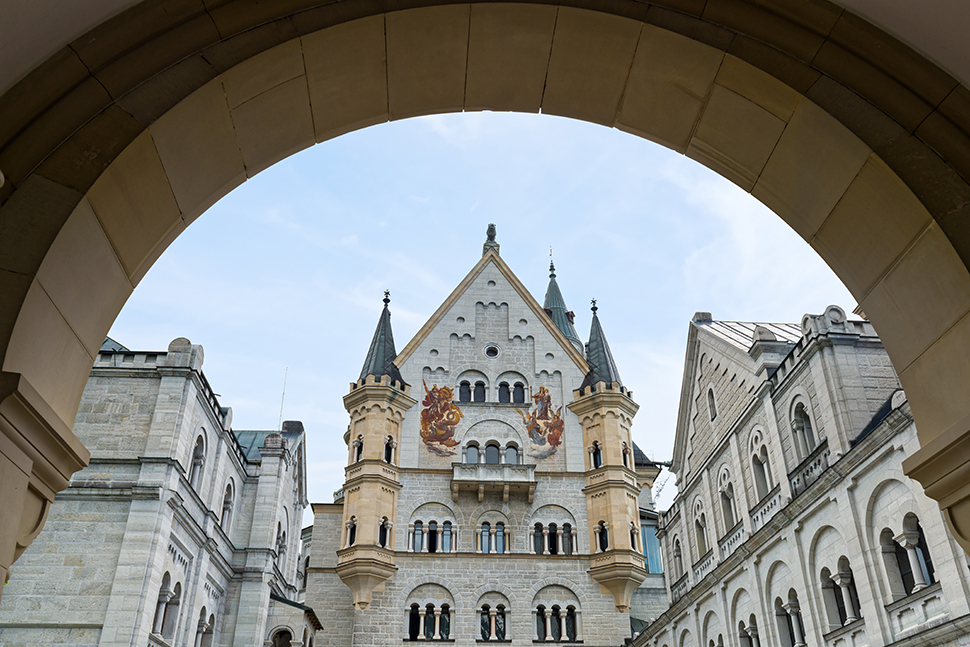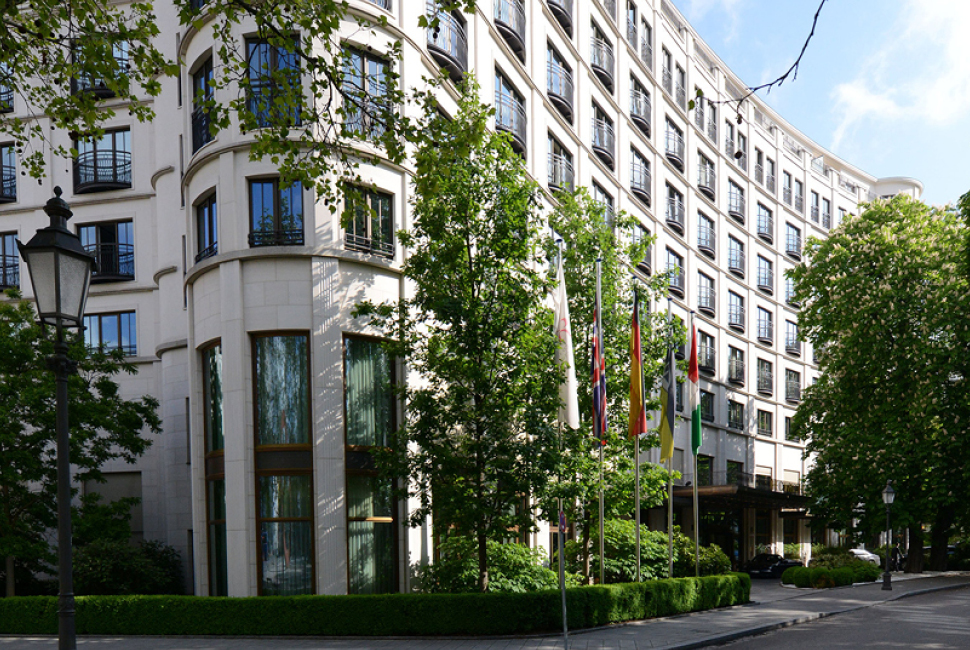

With their snow-capped peaks, rolling green foothills and thick, dark forests, Germany’s Bavarian Alps look like a fairytale setting. This enchanting corner of Southern Germany has ignited imaginations for centuries, setting the scene for iconic tales such as the medieval Pied Piper of Hamelin, Brothers Grimm’s 19th-century collection of folklore (see: Little Red Riding Hood and Hansel and Gretel) and more recent classics such as The Sound of Music (even though the musical is known for taking place in Austria, some of it was shot here). The mountains even inspired one Bavarian king to build a fantastical castle, which captured the attention of a certain American filmmaker named Walter Elias Disney.
But you don’t have to dive into the pages of a whimsical bedtime story to experience the magic for yourself. Get ready to head for the hills with this guide to Neuschwanstein Castle, Germany’s own fairytale come to life.
What is Neuschwanstein Castle?
Perched on a mountain slope in the Bavarian Alps, Neuschwanstein Castle looks more like a mythical movie set than a functional royal residence — and that’s intentional. The 19th-century palace was the brainchild of the reclusive King Ludwig II of Bavaria, who dreamed of a secluded retreat away from the bustle of Munich where he could live a courtly life far from prying eyes.
To satisfy his nostalgia for the Middle Ages, the king masterminded a palace inspired by a romanticized version of medieval life, complete with a gilded throne room, a feasting hall lit by candlelight and ornate decoration adorning every nook and cranny. But it’s also equipped with modern comforts like indoor plumbing and central heat.
Sadly, Ludwig’s vision was never fully realized. Construction stopped when the king mysteriously died in 1886, and the castle opened to the public shortly after as a museum that testified to the power of dreams and remains one of Germany’s most-visited attractions. If the facade looks familiar at first glance, that might be because you’ve seen it (or something like it) before. Neuschwanstein Castle famously inspired Disneyland’s Sleeping Beauty Castle in Anaheim, California; Walt Disney World’s Cinderella Castle in Orlando; and the brand’s signature castle logo.

How to explore Neuschwanstein Castle
Tours of Neuschwanstein Castle, required for entry, run like a well-oiled machine. Timed tickets ensure staggered visits, and audio guides in a dozen languages make the tour accessible to everyone.
Photography is prohibited inside the castle, so keep your phone in your pocket and your eyes and ears peeled for details about this stunning structure. A guide will usher your group from room to room and prompt your audio guide to begin at the appropriate time. The brief tour takes about 30 minutes, showcasing the castle’s highlights, and the small glimpse inside will leave even the staunchest architecture critic speechless.
One thing to note: The castle has been undergoing extensive renovations since 2017, so many passageways are covered in scaffolding and tucked behind curtains. The project is expected to wrap this fall, making winter or early 2025 a prime time to visit the newly restored treasure.
After your tour, you can hike further up the hill to take in the legendary view from Marienbrücke Bridge. Not for the faint of heart, the 200-year-old wooden bridge spans two hills over a steep ravine but offers breathtaking (and Instagrammable) views of Neuschwanstein Castle peeking through the dense Alpine forest.
What to do near Neuschwanstein Castle
Once you’ve gotten your fill of fairytale-worthy vistas, head down the hill from Neuschwanstein to Hohenschwangau Castle. Another 19th-century masterpiece, this much more functional palace served as the country residence of King Maximilian II and his family — including his son, Neuschwanstein architect Ludwig II.
Tours of Hohenschwangau work much the same as those in Neuschwanstein, though they tend to be less crowded. One major perk of the Hohenschwangau tour is that your guide will allow you to take one photo from an extremely scenic vantage point inside the castle. If you still haven’t had your fill of history after this much more thorough tour, the nearby Museum of the Bavarian Kings should sate your appetite.

How to get to Neuschwanstein Castle from Munich
Neuschwanstein Castle’s purposeful placement in the middle of nowhere might make it seem like a daunting excursion, but the palace is a fairly straightforward day trip from Munich. All it takes is a little planning.
For the easiest start to your day, choose a luxurious home base near München Hauptbahnhof (Munich’s main train station). Forbes Travel Guide Four-Star The Charles Hotel, a Rocco Forte Hotel or Forbes Travel Guide Recommended Sofitel Munich Bayerpost are great options. Request an early wake-up call and a quick room service breakfast before catching the two-hour train to Füssen, a tiny town in the Alpine foothills with a name that translates to “foot.”
If you want to drive, you will have to go to the village of Hohenschwangau, park there and then walk about 30 to 40 minutes on a steep uphill road to the castle. To take public transportation, purchase a Bayern ticket at one of the train station’s red machines or online in advance. This regional train ticket covers your roundtrip fare from Munich to Füssen and the 10-minute bus ride up to Schwangau, the village at the foot of Neuschwanstein Castle. The direct train from München Hauptbahnhof to Füssen leaves every two hours starting at 9:41 a.m. and makes for a scenic, Instagram-worthy ride through the countryside.
The Bayern ticket is valid all day and night on weekends but only after 9 a.m. on weekdays. If you want to leave earlier to beat the crowds, you can take another regional train that departs every hour; just bear in mind that you’ll need to purchase a one-way ticket (that doesn’t include the bus fare to Schwangau), and you’ll have to transfer trains about halfway through.
Once you arrive in Füssen, you’ll head through the tiny town train station to the adjacent bus stop. Look for line 73 or 78, show your Bayern ticket to board and disembark at the Hohenschwangau stop. When in doubt, follow the crowds — it’s likely that you’re all heading to the same place.
Upon arrival in the village of Schwangau, you can either purchase tickets for Neuschwanstein at the ticket office or, if you snagged your tickets online in advance, you can head straight to the shuttle stop for a quick ride up to the castle. Adventurous types can make the trek on foot, but at just under $3 roundtrip, the shuttle is well worth the short wait. Horse-drawn carriages are also available for transport in the summer months and add an extra air of romance to your fairytale excursion.
When you’re ready to depart from your side trip to Hohenschwangau Castle, simply hop back on bus 73 or 78 for the ride down to Füssen. Once you’re there, wander the town’s charming streets, visit local shops and grab a bite to eat at a Bavarian eatery like Madame Plüsch or Beim Olivenbauer. Heading back to Munich is as simple as boarding the next train — just bear in mind that the last direct train from Füssen to Munich departs at 6:05 p.m.
